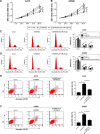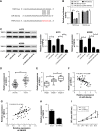LncRNA SNHG5 promotes growth and invasion in melanoma by regulating the miR-26a-5p/TRPC3 pathway
- PMID: 30636880
- PMCID: PMC6309782
- DOI: 10.2147/OTT.S184078
LncRNA SNHG5 promotes growth and invasion in melanoma by regulating the miR-26a-5p/TRPC3 pathway
Abstract
Introduction: Melanoma has been reported as the most common malignancy in skin cancer. The small nucleolar RNA host gene 5 (SNHG5), an lncRNA, has been proven as a vital regulator in several types of carcinoma. This study was designed to investigate the detailed roles and possible mechanisms of SNHG5 in melanoma progression.
Methods: Quantitative real-time PCR (qRT-PCR) analysis was conducted to detect the expression levels of SNHG5, miR-26a-5p and transient receptor potential, canonical 3 (TRPC3) mRNA in melanoma tissues and cells. CCK-8 assay was used to measure the cell viability. Flow cytometry assays were performed to determine the cell cycle distribution and apoptosis. The invasive ability was assessed by a 24-well Transwell insert. Western blot analysis was employed to evaluate the protein expression of TRPC3. Dual luciferase reporter assay, RNA immunoprecipitation (RIP) assay, and RNA pull-down assay were applied to identify the interactions among SNHG5, miR-26a-5p and TRPC3.
Results: The results showed that SNHG5 expression was increased in melanoma tumor tissues and cell lines. Higher SNHG5 expression was correlated with advanced pathogenic status. Moreover, SNHG5 could serve as a molecular sponge of miR-26a-5p. SNHG5 downregulation repressed proliferation, promoted apoptosis, and decreased invasion in melanoma cells, while these effects were greatly counteracted by miR-26a-5p inhibitor. Furthermore, miR-26a-5p directly targeted TRPC3 to suppress its expression, and this effect was aggravated following SNHG5 downregulation. Also, TRPC3 depletion exerted similar tumor-suppressive functions as SNHG5 knockdown.
Conclusion: SNHG5 promoted melanoma development by inhibiting miR-26a-5p and facilitating TRPC3 expression, highlighting the potential of SNHG5 as a novel target therapy for melanoma.
Keywords: SNHG5; TRPC3; cutaneum carcinoma; lncRNA; miR-26a-5p.
Conflict of interest statement
Disclosure The authors report no conflicts of interest in this work.
Figures






References
-
- Siegel RL, Miller KD, Jemal A. Cancer statistics, 2016. CA Cancer J Clin. 2016;6666(1):7–30. - PubMed
-
- Siegel RL, Miller KD, Jemal A. Cancer Statistics, 2017. CA Cancer J Clin. 2017;6767(1):7–30. - PubMed
-
- Boada A, Carrera C, Segura S, et al. Cutaneous toxicities of new treatments for melanoma. Clin Transl Oncol. 2018;20(11):1373–1384. - PubMed
LinkOut - more resources
Full Text Sources
Miscellaneous

